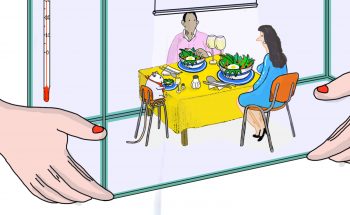
Radio Ambulante enters the classroom
Share:
This is the first post in a series about using Radio Ambulante in the classroom. Read the second post here, the third here, and the fourth here.
Over the past 6 months, along with Silvia Viñas and Clara González Sueyro, I have been learning about the ways in which Radio Ambulante is being used in the Spanish language classroom. Thanks to information gleaned through in depth surveys with a small group of teachers as well as new contacts gathered through this survey, we know that many non-Spanish speakers use Radio Ambulante as a way to practice or perfect their Spanish language listening skills. We have received great feedback from individual listeners about how helpful the transcripts, translations and youtube videos with subtitles have been for practicing their Spanish.
We have also talked and corresponded with teachers from all over the country about how they are using our episodes as a part of their curriculum. This initiative, called Radio Ambulante in the Classroom (#RAintheclassroom), both seeks to learn as well as promote how teachers use our materials with their students.
#RAintheclassroom also wants to learn from teachers who want to use our stories but currently are not. What kinds of scaffolding, lesson plans, ancillary materials should we think about creating to make our materials accessible to both those who use our stories with their students but also those who are eager to do so.
Recently I gave a presentation at the annual ACTFL convention about this topic. A quick survey of hands in the room showed that 75% of the audience was avid listeners, about 25% was not, but only 2 or 3 listeners currently used RA in the classroom. That pretty much corresponds to what we have been seeing in our interviews and survey results. And yet, when I asked the entire group to do a brainstorming session to think about ways to use a clip from The Stowaways with students, the room exploded in conversation and was overflowing with creative ideas and suggestions.
The ideas, the creativity, the possibilities are there. So what is holding people back?
One of the biggest obstacles is time. It takes time to create a thoughtful lesson plan that is properly scaffolded to the level of the students we teach. Finding space in the syllabus is also a challenge; many syllabi are so tightly choreographed that it is impossible to add material mid stream. And teachers are often teaching more than one class so that their own personal time leaves no space for thinking of ways to add, move, subtract materials mid term. Those decisions have to be made well in advance of the semester.
Knowing this, I came up with some ideas about possible ways in which Radio Ambulante could be included in a 2nd or 3rd year Spanish language classroom.
Connecting RA stories with intermediate level textbook chapter themes:
One of the places where RA’s stories can be utilized is to counteract the often problematic references to language and culture that are seen in standard issue language textbooks. Far too often textbooks resort to a superficial and monolithic treatment of race, diversity, social justice, inequality in Latin America and do not make space for students to see the variety and the complexity of the people and cultures that make up Latin America.
Teaching listening:
Listening receives little if any explicit support in most language classes. The general assumption has been that if we just give our students lots of input (sound) they will eventually “get it.” Current research is showing us that listening is not a passive activity, rather, it is a dynamic process involving top-down and bottom-up processing of information (often simultaneously). In order for our students to acquire listening proficiency, we need to provide them learning strategies as well as scaffolded exercises for gradual comprehension of the listening materials. RA provides students with challenging and yet captivating storytelling in authentic dialects of the spoken language. What is more, students often relate to the topics being discussed and are motivated to listen closely in order to discuss them with others.
Teaching social justice:
The process of learning a new language is intrinsically connected to the people and the places where that language is spoken, as well as the lives of the people who speak it. While it is important to study the mechanics of the language, it is also important to share with our students the realities of Spanish speaking communities where issues of social justice are not just academic…they are essential. RA provides our students with compelling stories that often touch upon issues of justice, equality, fairness and that are not always heard through mainstream media. These stories challenge, disrupt and confront untruths, stereotypes and misconceptions and ask our students to think in a different way about Latinos and Latin Americans.
To kick things off, I am sharing a lesson plan that I created (with the help of my teaching assistant Rebecca Cohen) for students in a 300 level college Spanish course. The lesson plan focuses on helping students develop intentional listening practices in Spanish while studying the Radio Ambulante episode El equipo fantasma. I welcome your comments!
El Equipo Fantasma Lesson Plan 2016
Download the file in slideshare
From December through February, Radio Ambulante will go on a well deserved hiatus. While the team is working on new stories, this blog will feature the work of teachers who currently use #RAintheclassroom. We have heard some amazing things from teachers and we can’t wait to have the teachers share them with you!
Do you have a story you would like to share? Please contact me! [email protected].
And if you are a teacher and have not yet signed up for our survey and newsletter, please do so by clicking here!
Best of luck with the end of your term and may you have a restful break!





